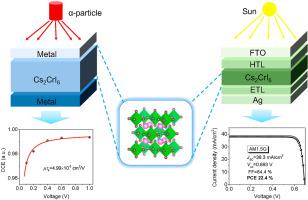Materials Today Physics ( IF 10.0 ) Pub Date : 2021-05-27 , DOI: 10.1016/j.mtphys.2021.100446 Peng Zhao , Jie Su , Yujia Guo , Lu Wang , Zhenhua Lin , Jincheng Zhang , Yue Hao , Xiaoping Ouyang , Jingjing Chang

|
Although MAPbI3 photovoltaics have gained increasing interest for space application, its low stability and radiation resistance is insurmountable. Here, we unexpectedly find a new vacancy-ordered double perovskite Cs2CrI6 to realize high-performance space solar cells and α-particle detectors through an innovative multi-scale simulation strategy based on the first-principle calculations coupling with drift-diffusion model and Monte Carlo method. Compared to the MAPbI3, Cs2CrI6 possesses more excellent stability and optical absorption, suitable band gap (1.08 eV), higher mobility (∼103 cm2/V) and lower capture cross-section. These lead to the ultra-high power conversion efficiency (PCE) for single-junction solar cells (22.4%) and monolithic all-perovskite tandem solar cells (26.6%), and excellent α-particle detectors with ultra-high charge collection efficiency (CCE = 99.3%) and mobility-lifetime product (μτh = 4.99 × 10−3 cm2V−1), which are superior to those of corresponding MAPbI3 devices. Meanwhile, the 90% of initial PCE can be remained even under the 5 × 1013 p. cm−2 fluence proton beam and several orders higher than traditional space solar cell. Moreover, the proton irradiation resistance of Cs2CrI6 α-particle detection can reach up to 1016 p. cm−2. The excellent device performance and irradiation resistance of Cs2CrI6 devices indicate the great potential application in photovoltaic cells, α-particle detectors and even their space applications.
中文翻译:

一种新型全无机空位有序双钙钛矿Cs 2 CrI 6用于高性能光伏电池和空间环境中的α粒子检测
尽管MAPbI 3光伏在空间应用中越来越受到关注,但其低稳定性和抗辐射性是无法克服的。在这里,我们意外地发现了一种新的空位有序双钙钛矿Cs 2 CrI 6,通过基于第一性原理计算结合漂移扩散模型的创新多尺度模拟策略来实现高性能空间太阳能电池和α粒子探测器和蒙特卡罗方法。相较于MAPbI 3,Cs的2值CrI 6具有更优异的稳定性和光吸收,合适的带隙(1.08电子伏特),更高的迁移率(〜10 3 厘米2/V) 和较低的捕获横截面。这些导致单结太阳能电池(22.4%)和单片全钙钛矿串联太阳能电池(26.6%)的超高功率转换效率(PCE),以及具有超高电荷收集效率的优秀α粒子探测器( CCE = 99.3%) 和迁移率寿命乘积 ( μτ h = 4.99 × 10 -3 cm 2 V -1 ),优于相应的 MAPbI 3器件。同时,即使在 5 × 10 13 p下,初始 PCE 的 90% 仍可保持。cm -2通量质子束,比传统空间太阳能电池高几个数量级。此外,Cs 2的质子辐照电阻CrI 6 α粒子检测可达10 16 p。厘米-2。Cs 2 CrI 6器件优异的器件性能和耐辐照性表明其在光伏电池、α粒子探测器甚至空间应用方面具有巨大的应用潜力。









































 京公网安备 11010802027423号
京公网安备 11010802027423号